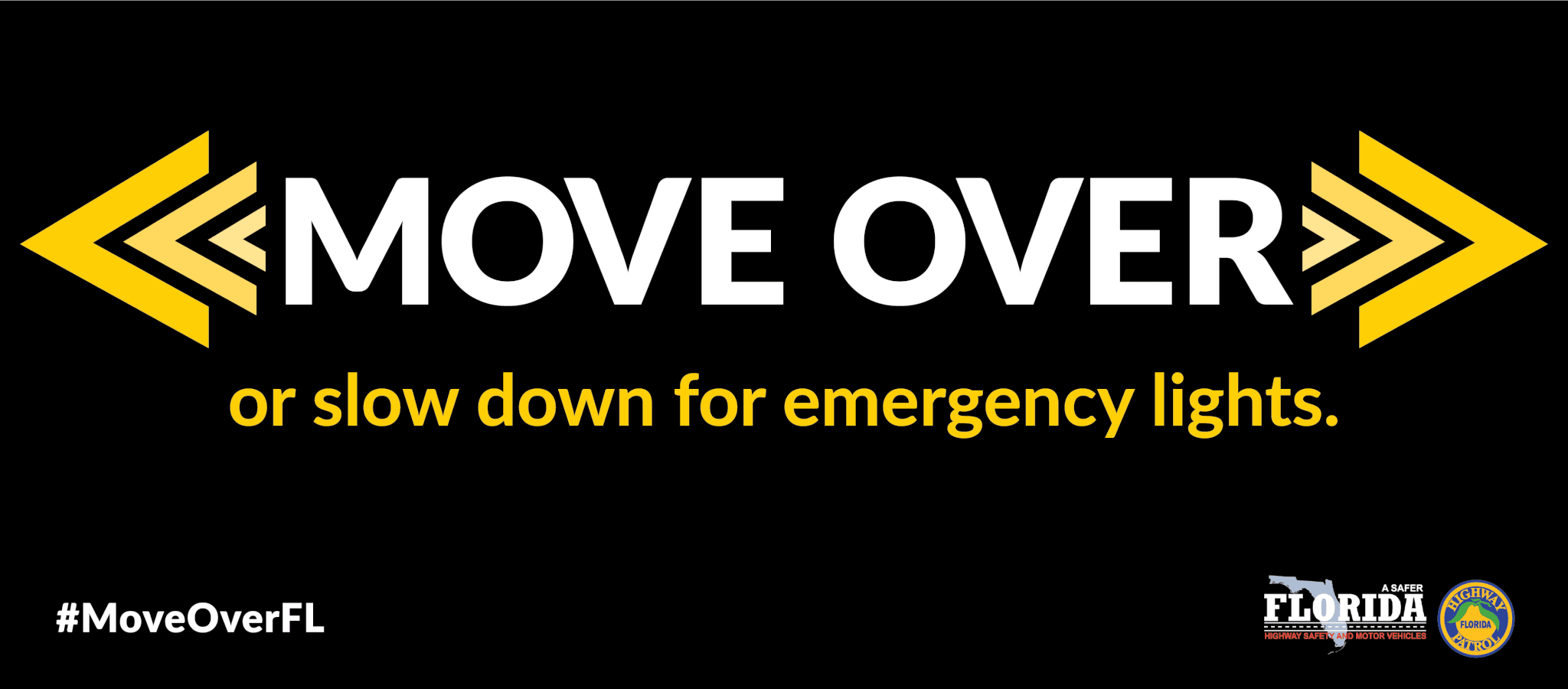When traveling to or living in Florida, it’s imperative that you understand the “Move Over” law, both for your safety and for the safety of those around you.
Our nearby Tampa, Florida car accident attorneys will explain.
Wondering About Florida’s Move Over Law?
If you’ve been wondering about Florida’s Move Over Law, here are some key details to keep you informed and safe on the road. The Florida Move Over Law mandates that when drivers approach a stationary emergency or service vehicle, such as tow trucks, utility service vehicles, or sanitation vehicles, with activated lights, to either change lanes if possible or, if unable to do so, slow down to a speed 20 mph less than the posted limit. The Florida Move Over Law is applicable on two-lane roads as well, and its goal is to improve the safety of emergency personnel and service workers on the state’s roads.
What If I Can’t Move Over?

Here’s how to comply with the Move Over law if you cannot move over due to traffic conditions:
- You must slow your vehicle to a speed that’s 20 mph lower than the currently posted speed limit. This rule also applies if you are driving on a road with only a single lane.
- Should the speed limit be 20 mph or under, you should slow your speed to 5 mph.
Understanding the Move Over Law in Florida
That’s the basic gist of the Move Over law in Florida. Further details are outlined below:
- When an emergency services vehicle approaches with lights or sirens on, all motorists must immediately yield the right-of-way. You should move your vehicle either over the curb or as close to the curb as you safely can, yield parallel to the white line, and allow the vehicle to pass. Emergency services vehicles with lights and sirens activated are en route to or coming from an emergency, and their work is time-sensitive. Yielding the right-of-way saves lives.
- As mentioned, drivers must move from the closest lane to a parked utility or emergency vehicle when it is safe to do so. The only exception is when a law enforcement official directs traffic otherwise.
- Cars should never cross the yellow line to vacate the lane. On one-lane roads, vehicles should instead slow down as previously indicated.
- The DHSMV is required to create an awareness campaign to inform drivers about the law. All driving education materials printed and published after the law went into effect have information about the law.
- Pedestrians usually have the right-of-way by default. However, when an emergency vehicle passes with lights or sirens activated, the pedestrian must yield the right-of-way to the vehicle. The only exception is if a law enforcement official directs otherwise.
- Emergency vehicles are legally required to use their sirens or lights to inform motorists when they are en route to an emergency. Emergency vehicles must also comply with vehicular traffic laws while traveling to emergencies.
- Emergency vehicle drivers are responsible for conducting their vehicles in a safe manner.
- All laws and regulations regarding driver responsibility, both for normal vehicles and emergency vehicles, remain unchanged.
What is the Penalty for Violating the Move Over Law?
The penalty for noncompliance with the Move Over law is a noncriminal infraction. You will be given a fine, additional fees, and have three points added to your driving record.
It’s important to be familiar with this law. Move Over laws have been passed in forty-three of fifty states; it’s not just a courtesy, it’s the law.
Under the Move Over Law Florida statute, drivers are required to safely change lanes or slow down when approaching stopped emergency or service vehicles with their lights activated on the roadside. When you fail to move over or slow down, you put the lives of emergency and utility workers at risk.
Consequences of Drivers Failing to Move Over
In Florida in 2017, there were 212 crashes caused by vehicles failing to move over. In addition, more than 17,000 citations were issued to motorists who refused to move over.
The DHSMV does its best to educate drivers about the law, but many people continue to ignore it.
The Move Over Law went into effect in 2002. Many older motorists received their licenses prior to the law’s passing and genuinely do not know of its existence.
Current DHSMV handbooks have educational information about the Move Over Law, but drivers prior to 2002 didn’t have these educational materials while learning to drive.
The leading cause of law enforcement officer deaths in Florida in 2017 was traffic-related fatalities, many of which occurred because drivers didn’t comply with the Move Over law. It cannot be emphasized enough as to how important it is to keep roadside workers safe.
Oftentimes law enforcement and public service workers cannot be easily seen from the road, especially in poor weather conditions or during the night. Working on the side of busy roads is a huge safety hazard, one that’s easily mitigated when drivers slow down.
Move over and watch carefully.
Raising Awareness of the Florida Move Over Law
The Florida DHSMV is partnering with AAA, the Florida Sheriffs Association, the Florida Department of Transportation, and the Florida Police Chiefs Association to increase awareness of the Move Over law and help keep roadside workers safer in 2018. The Move Over, Florida! campaign aims to increase awareness and compliance with the law.
The campaign is sorely needed and has been embraced by emergency and public service workers. Seventy-one percent of Americans have never even heard of “Move Over” laws.
Even so, eighty-six percent of Americans support nationwide “Move Over” laws (currently these laws exist in only forty-three out of fifty states). Ninety percent of Americans concur that roadside emergencies and traffic stops are dangerous for first responders and for law enforcement.
If you’re traveling to Florida from out-of-state, the Move Over law is one of the first you should familiarize yourself with. Individual states have slightly different laws and penalties for violating those laws.
Whenever you travel or vacation to a new state, you should look up the traffic laws that differ from those in your own state.
For example, some state laws lack language specifically requiring a vehicle to move into another lane. In certain states, vehicles are only required to give emergency and utility vehicles a “wide berth,” which doesn’t necessarily include a lane change.
Certain other states and territories lack laws about slowing down when passing vehicles parked on the shoulder, regardless of whether or not they’ve implemented a move-over law.
Move Over, America! is a group that advocates for the implementation of move-over laws across the entire nation. The partnership was founded in 2007 and has the backing of the National Sheriffs’ Association, the National Safety Commission, and other road safety coalitions. Move Over, America! documents news regarding move-over laws and new legislation. The group also creates awareness campaigns with the goal of protecting safety officers nationwide.
The next time you’re driving in Florida, remember to do the right thing when you see a stopped emergency vehicle and move over.
This is a public service post for all road users in Florida.
Understanding the FSS Move-Over Law
The Florida Statute (FSS) Move Over Law was designed to enhance road safety in the state. It mandates that drivers must move over a lane when approaching authorized emergency vehicles and service vehicles parked on the side of the road with their lights activated. This law helps protect the lives of law enforcement officers, emergency responders, and service personnel while they work on the roadside. Failure to comply with the FSS Move Over Law can result in fines and penalties. By obeying this law, drivers can contribute to a safer and more secure driving environment for everyone on Florida’s roads.
Florida Left Lane Law Explained
Under the Florida Left Lane Law, drivers must not remain in the leftmost lane when they are aware, or should reasonably be aware, that a faster vehicle is overtaking them from behind unless the driver is preparing for a left-hand turn at an intersection. Failure to yield the left lane will result in a noncriminal traffic infraction, subject to penalties as a moving violation.
The Florida Left Lane Law is applicable on roadways, streets, and highways featuring more than two lanes heading in the same direction. By adhering to this law, drivers can help reduce congestion, enhance overall road safety, and ensure a smoother driving experience for all.
Were You Injured in a Florida Car Accident?
If you have been injured in a car accident in Florida, don’t hesitate to contact the experienced lawyers at Abrahamson & Uiterwyk. Our experienced nearby Florida car accident attorneys specialize in personal injury cases and are ready to provide the guidance and support you need. By assessing the specific details of your case, we can navigate the legal process on your behalf, advocating for your rights and fighting to secure the compensation you rightfully deserve for your injuries and losses. Contact our nearby injury law team at 1-800-538-4878 for a free case evaluation today.
Recommended Resources:
https://www.flhsmv.gov/safety-center/driving-safety/move-over/
http://www.leg.state.fl.us/Statutes/index.cfm?App_mode=Display_Statute&URL=0300-0399/0316/Sections/0316.126.html
https://www.flhsmv.gov/2018/01/02/move-florida-law/



